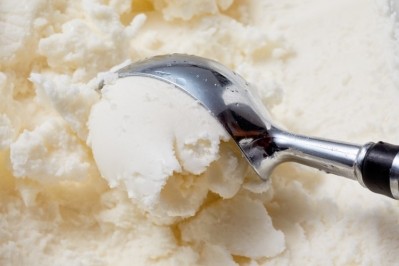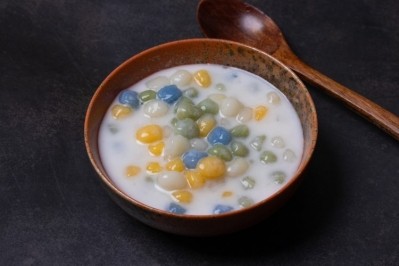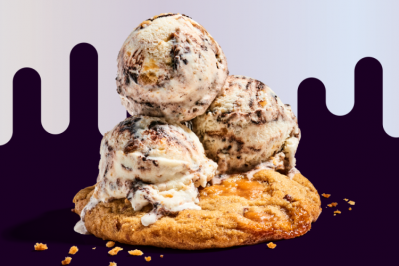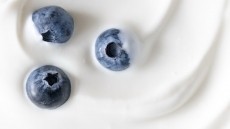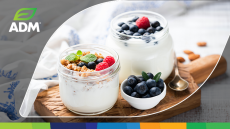From the familiar to the exotic: Which ice cream trends are driving the category in 2023?

After the pandemic pushed the category off its growth trajectory, ice cream is expected to bounce back to its 2019 volume levels this year. Across the frozen aisle, plant-based alternatives stand out in terms of growth potential, while flavor innovation has been influenced by bakery staples and exotic cuisines that keep consumers excited.
Health continues to drive consumer-buying habits too, but in a category so strongly associated with indulgence, it’s important to get every aspect – from sweetness profile to texture – right in order to win over shoppers who want to ‘be good’ without missing out on the full sensory and flavor experience that ice cream provides.
DairyReporter spoke to ingredient specialists from Cargill, IFF and SVZ to find out how ingredient innovation can help manufacturers capture consumers’ attention; what are the hot flavor trends in the frozen aisle; and why plant-based is becoming an increasingly important sub-category.
Market resilience
Quoting Euromonitor data, Rogerio de Almeida Prado, global innovation marketing leader for bakery, bars and confectionary at IFF, noted that ice cream recorded a 5% volume decline in 2020, and the inflationary pressures of the past year have had a negative impact on the category’s recovery. “Despite these challenges, the projections suggest that the category will reach pre-pandemic volume levels in 2023,” he said. “And it has been varying depending on the region. For example, in the US, it is anticipated to have achieved this milestone by 2022, while in LATAM, the recovery is expected to extend into 2023. These projections indicate a positive outlook for the category, signalling a potential rebound from the disruptions caused by market turbulence.”
Cargill’s Aysegul Ozcan, marketing manager, sweetness & texture, said that according to the company’s trends report, confectionery was reporting growth and is considered ‘an affordable luxury’ during economic hardship. “Developers are serving up comfort with super sweet flavours and twists on classics,” she told us.
For SVZ business intelligence manager Dejan Trifunović, despite the category’s universal appeal, innovation remains important to retaining consumer interest. “Thanks to its versatility and delicious taste, ice cream remains an iconic dessert and - perhaps unsurprisingly - the most consumed one worldwide,” he said. “However, like any other food category, the ice cream industry isn’t immune to change and needs to constantly evolve to adapt to new consumer trends and preferences.”
From exotic fruit to umami flavors
So what flavors, formats and textures have come to the fore? “Recent years have seen an explosion in unexpected, more adventurous combinations, driven by both younger generations’ interest in diverse and unusual flavours and a need, especially during the COVID-19 pandemic, to explore new and exciting tastes that offer a moment of escapism,” explained Trifunović. “From the fusion of sweet and savoury flavours, such as salted caramel with chocolate or rosemary, olive oil and sea salt, to the rise of floral ingredients like lavender, and the addition of herbal notes such as saffron and tarragon – the popularity of these combinations comes from the pursuit of memorable taste experiences.”
Meanwhile, all-time favorites and nostalgia-inducing flavors are equally attractive. “Fruits, for example, accounted for 18% of new product launches in Europe between January 2022 and May 2023, with strawberry amongst the top 3 leading flavours,” said Trifunović.
“Whether used alone, or in combination with flavours from meringue to citrus, the versatility and popularity of simple fruit ingredients in creamy desserts is unmatched.” – Dejan Trifunović, SVZ
Quoting The Food People, Cargill’s proprietary Trend Report 2023, Cargill’s EMEA commercial marketing lead Philippe Bernay said that while all-time favorites such as chocolate, strawberry and vanilla are still the most popular, bakery-inspired flavors like treacle, butterscotch, and dulce de leche are experiencing a resurgence. “Caramelised biscuit has boosted flavor innovation in other categories, including desserts and baked goods,” he said.
IFF’s Rogerio de Almeida Prado backed exotic and nostalgia-inducing flavors to be on-trend this season. “Key trends include bold and exotic flavors like matcha and lavender, indulgent profiles with chocolate fudge and caramel, inclusion of mix-ins and toppings for added texture, authentic inspirations from traditional desserts and global cuisines, and achieving creamy and smooth textures,” he told us. “Manufacturers are drawing inspiration from traditional desserts, regional cuisines, and global flavors, offering ice cream varieties like tiramisu, baklava, matcha mochi, or spiced chai.
“In the realm of artisanal gelato, there are notable trends that emphasize indulgence, premium ingredients, nostalgia, elevated classics, and healthier, free-from options. Consumers place importance on the origin of raw materials, preferring ice creams made with ethically-sourced and locally-produced ingredients. They appreciate flavors inspired by authentic and artisanal sources.”
“While there is room for innovation, consumers appreciate a balance of familiarity and comfort in their ice cream choices. Manufacturers can introduce unique twists in flavors while maintaining a level of familiarity that resonates with consumers and evokes a sense of nostalgia.” - Rogerio de Almeida Prado, IFF
Cargill’s Ozcan added that creating products that ‘surprise and delight’ is ‘all the rage’ now. “Product developers are re-imagining the category with gourmet flavors, novel textures, and surprising ingredients, often inspired by global culinary trends,” she said. “Artisanal and small-batch ice creams have surged in popularity, captivating consumers with their unique and inventive flavor combinations. These artisanal creations prioritize high-quality ingredients, expert craftsmanship, and culinary creativity. Unconventional pairings like salted caramel and flavors inspired by global cuisines such as ube malt or sticky rice mango have delighted ice cream enthusiasts, while exotic fruit blends and the inclusion of cookies, cereals, and dessert-inspired elements have provided a truly indulgent and sensorial experience.”
Ozcan continued: “Regarding multi-sensorial experiences, inclusions have been on the rise among novelty ice creams.
“Inclusions such as bubble pearls can be found in ice cream gallon containers as well as ice cream novelty bars. That brings excitement to ice cream consumers looking for surprises in texture in their ice cream experience.” Aysegul Ozcan, Cargill
Balancing health benefits with indulgence
Over the last few years, consumers have grown more aware of the role food plays in their physical and mental wellbeing. A Deloitte survey of 17,000 European consumers revealed 64% had become more interested in learning about the influence of food on their health, with 70% stating they would pay a 5% premium for organic foods or foods that are locally- or sustainably-sourced.
With ice cream associated with indulgence, is there scope for creating and marketing health-boosting frozen desserts? “Given that ice cream is typically perceived as an indulgent treat, there is often a concern that low-sugar or healthier options may compromise taste and texture,” IFF’s Rogerio de Almeida Prado opened. “However, advancements in technology can help bridge this gap by delivering great taste to healthier ice cream formulations and providing the indulgent experience consumers expect.”
It is equally important to address the misconception that low-sugar or better-for-you ice cream may not taste as good, we were told. “Manufacturers can highlight the use of high-quality ingredients, innovative technologies, and flavor enhancements that create delicious and satisfying products,” he said. “Demonstrating the ability to deliver on taste and texture while reducing sugar or incorporating healthier ingredients is crucial to win over consumers who may be sceptical about healthier ice cream options.”
Cargill’s Ozcan highlighted that sweeteners still have a major role to play in sugar reduction. “While consumer interest in reduction of sugars is evident, taste remains the number-one priority – particularly when it comes to indulgent products like ice cream. Sweeteners such as erythritol can help deliver a sweet taste similar to sugar, but without the calories. They can help deliver additional attributes that are well-suited for indulgent products while providing optimal freezing point depression and enhanced bulk and body.” She suggested that ice cream was an obvious application for stevia.
Label information matters
There’s appetite for no-added-sugar and high-protein desserts, Ozcan told us, adding: “A Nutri-Score improvement in terms of sugar reduction may allow for an overall improvement to the nutritional composition of the entire matrix, and thereby could potentially enable credible health marketing.”
Ozcan also noted that between half and two thirds of consumers feel that nutritional information is impactful, according to Cargill research, while 49% state it is ‘extremely’ or ‘very important’ when it comes to ice cream. But for those that seek indulgence, the sensory experience is paramount. “There will always be a segment of consumers who are only interested in straight up indulgence – seeking out the smoothest and creamiest, most decadent experience possible,” she told us. “For them, flavor development is key, and developers may want to continue to surprise and delight consumers with gourmet flavors, novel textures, and surprising ingredients.”
IFF’s Rogerio de Almeida Prado suggested that well-known ingredients can add flavor but also nutritional value. “Delivering on both health and indulgence can be challenging and might seem somewhat contradictory, but this is where functional and nutritional elements have an important role to play,” he said. “By incorporating a handful of simple, high-quality ingredients such as fruit purees or vegetable juice concentrates into their ice cream recipes, manufacturers can exceed consumers’ taste expectations while adding in extra nutrients and vitamins.”
Plant-based: an untapped opportunity
One sub-category of frozen desserts that has shot up in terms of volume sales has been plant-based ice cream. The segment has gained considerable popularity in recent years, recording an annual CAGR of 16% in volume from 2019 to 2022 while ice cream declined 0.4%, according to Euromonitor.
For SVZ’s Dejan Trifunović, plant-based ice cream offers a growth opportunity. “The shift in consumer behaviour towards prioritising health and wellbeing unlocks the possibility for ice cream brands to explore the ‘health halo’ typically associated with plant-based products. In many regions, plant-based ice cream hasn’t yet reached peak popularity – in China, for example, nearly 70% of adults haven’t tried it. This lack of familiarity means there’s an untapped opportunity for manufacturers to give their plant-based recipes a ‘healthful boost’ with clean-label and nutritious ingredients.”
But taste can be a hurdle, he added. “A recent study found that consumers who viewed plant-based options as replacements for traditional dairy products, rather than as new experiences per se, expressed greater dissatisfaction with these alternatives. As a result, improving consumer perceptions of plant-based ice cream’s taste and texture remains key for success in this category.”
Cargill’s Ozcan agreed that while consumers are open to plant-based dairy alternatives, these products are rife with formulation complexities. “A major challenge that manufacturers must consider is how to keep the satisfying flavor in plant-based desserts and ice creams. Plant proteins have a reputation for off-notes, so it’s important to choose options with the most neutral profiles possible. The latest addition to our pea protein line-up allows us to achieve not only higher levels of protein thanks to its enhanced solubility but also improved flavor profile. The resulting plant-based frozen desserts aim to deliver on consumers’ sensory and nutritional expectations, with improved textures, creamier mouthfeels, and great taste.
“Another challenge is that plant proteins create textural differences, impacting hardness and melting properties – attributes we’d typically manage with sugar [though other solutions are also available, ed.]. Then, to address bulking and freezing point depression, erythritol may be a suitable option – which can help fill those functional gaps. We’re also seeing brands boost the nutritional profiles of their products with fiber, which could help with sugar reduction, serve as a bulking agent, and enable fiber-related claims.”
Cargill’s commercial lead Michel van der Poel added that fats and oils are delivering some of the most exciting innovations in plant-based ice creams. “New innovations, such as ‘smart fat’ solutions that use structured emulsions, can more closely mimic the functional roles of traditional animal fats,” he said.
Another area of innovation relates to the development of alternative bases made from plant-based ingredients, as IFF’s Rogerio de Almeida Prado told us: “Previously, options were limited to soy or almond milk, but now, a wide range of plant-based alternatives such as coconut milk, oat milk, cashew milk, and pea protein have emerged. These alternative bases provide improved texture and creaminess, bringing dairy-free options closer to the mouthfeel and sensory experience of traditional dairy ice cream.”
“In terms of flavor variety, manufacturers have expanded their offerings to include a diverse range of innovative and indulgent flavors in dairy-free options. Unique combinations like cookie dough, salted caramel, mint chocolate chip, and fruity sorbets have become more readily available, catering to a wide range of consumer preferences and offering a satisfying flavor experience.
He concluded: “Lastly, advancements in technology such as flavor delivery technology, modulation tools, emulsifiers and system blends have enabled the creation of satisfying authentic sweet taste experiences, improved richness, body, mouthfeel, and fullness, clean taste, and aromas. The areas of innovation show that we are in the right direction in bridging the gap and delivering a satisfying sensory experience to consumers.”

